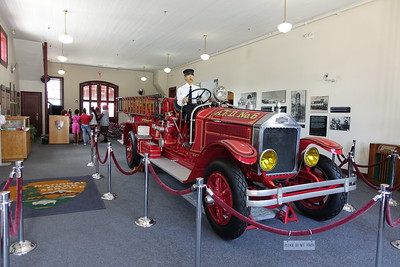AO Edited
Fire Station No. 6
The first integrated firehouse in Atlanta houses a museum on the history of desegregation in the city's fire department.
As a child, the Reverend Dr. Martin Luther King, Jr. would often play basketball behind a fire station in Atlanta’s historically Black neighborhood of Sweet Auburn. It’s a small coincidence that the fire station was built atop the former home of Theodore “Tiger” Flowers, the world’s first Black middleweight boxing champion; it’s a matter of much greater coincidence, though, that the very same station would later become the first racially integrated firehouse in the city, thanks to the dauntless bravery of 16 Black firefighters. A museum now housed in the defunct station outlines their accomplishments in desegregating the largest fire department in the American South, while also displaying historic firefighting equipment.
At the dawn of the Civil Rights Movement, Atlanta’s Black community began applying pressure on the mayor and city council to integrate the fire department, not only to provide employment opportunities, but more importantly to ensure that every neighborhood received equal protection from fire-related accidents. In 1962, Mayor Ivan Allen authorized the hiring, and though 16 Black men were recruited, they had to undergo training by white supervisors first.
Those first 16 Black firefighters attest to undergoing more than just a rigorous training: It was meant to deter them from enlisting entirely. The malevolent attempt at dissuasion had an opposite effect: The treatment they endured made them stronger, faster, more effective firefighters—the best in the city, they claimed.
While all 16 graduated training in April, 1963, they were initially placed in a station of their own—Station No. 16—instead of being integrated throughout the city. Firefighting is an intimate occupation, with employees living, eating, and sleeping together throughout their time on duty, and many white firefighters fought tooth and nail to resist full integration.
With the July 1964 passage of the Federal Civil Rights Act, however, segregated stations finally fell by the wayside, and new minority hiring practices brought even more Black firefighters onto the force. Station No. 6 was the first to formally desegregate, and retired firefighters recall arriving at the scenes of many fires to cheers and applause from onlookers. Station No. 6 housed an active, integrated force until 1991 when they were moved to a newer building nearby.
Beside a detailed history on the journey to integration, the museum that is now Historic Station No. 6 also features historic fire fighting equipment. There’s a 1927 LaFrance fire engine which was in use until the 1950s; original brass firepoles; and a 19th century fire alarm telegraph machine, which at one time would have connected to numbered boxes throughout the city that could be triggered in the event of a fire.
Community Contributors
Added by
Edited by
Plan Your Trip
The Atlas Obscura Podcast is Back!






















Follow us on Twitter to get the latest on the world's hidden wonders.
Like us on Facebook to get the latest on the world's hidden wonders.
Follow us on Twitter Like us on Facebook